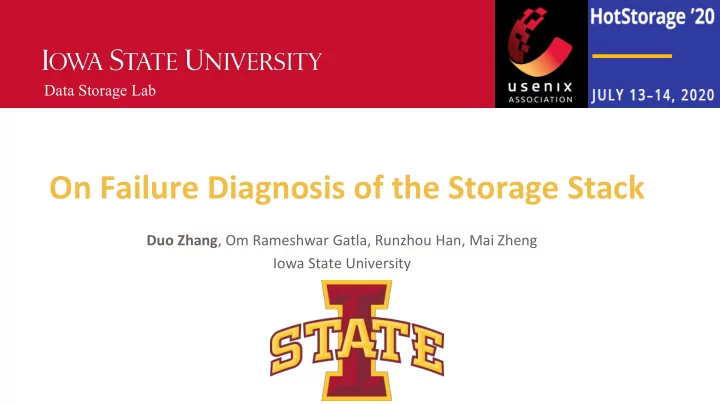

Data Storage Lab On Failure Diagnosis of the Storage Stack Duo Zhang , Om Rameshwar Gatla, Runzhou Han, Mai Zheng Iowa State University
Storage System Failures Are Troublesome 2 Data Storage Lab
Existing Efforts Are Not Enough • Mostly focus on testing Require a special testing environment • • e.g., a customized kernel • Still cannot prevent all failures in production environment 3 Data Storage Lab
Existing Efforts Are Not Enough • Mostly focus on testing Require a special testing environment • • e.g., a customized kernel • Still cannot prevent all failures in production environment What to do if failures happen ? 4 Data Storage Lab
Practical Diagnosis Tools & Limitations Ftrace strace SystemTap • Practical diagnosis tools Software-based • Application • e.g., GDB, SystemTap, Ftrace System Libraries perf • Hardware-based System Call e.g., Bus analyzer • VFS dtrace Limitations Ext4/… • blktrace Block layer • Require substantial manual efforts Device drivers • e.g., GDB single-stepping Require special hardware • I/O Controller • Only cover partial storage stack Bus analyzer SCSI Disk NVMe Disk 5 Data Storage Lab
A Real-World Case: Diagnosis Is Challenging • Algolia data center incident: Servers crashed and files corrupted for • unknown reason After weeks of diagnosis, Samsung SSDs • were mistakenly blamed • After one month, a Linux kernel bug was identified as root cause 6 Data Storage Lab
Our Approach 7 Data Storage Lab
X-Ray: A Cross-Layer Approach • Support unmodified software stack • Intercept device activity without relying on kernel or special hardware • Visualize multi-layer correlation Narrow down root cause (semi)automatically • 8 Data Storage Lab
X-Ray: A Cross-Layer Approach • HostAgent: help understand host-side system activities Trace host-side events • • e.g., syscalls, kernel functions 9 Data Storage Lab
X-Ray: A Cross-Layer Approach • DevAgent: help understand changes of persistent states Trace device commands • • e.g., SCSI, NVMe 10 Data Storage Lab
X-Ray: A Cross-Layer Approach • X-Explorer: facilitate diagnosis in two ways Build and visualize multi-layer correlation (i.e., correlation tree) • • Highlight critical nodes/paths based on rules 11 Data Storage Lab
Key Challenge #1 • How to correlate information across layers ? 12 Data Storage Lab
Key Challenge #1 • How to correlate information across layers ? Cannot use SCSI/NVMe hints • • Require modification to workload/OS • Use timestamp Customized Ftrace frontend • Convert execution time to epoch time • • NTP(Network Time Protocol) based synchronization • Solve accuracy problem caused by virtualization 13 Data Storage Lab
Key Challenge #2 • How to reduce manual efforts ? 14 Data Storage Lab
Key Challenge #2 • How to reduce manual efforts ? Visualize cross-layer events & dependencies in a correlation tree • Dependency syscall Syscall → B Syscall → C C → D B C C I C → E Syscall → C D E K F C → F F → G G → CMD G Syscall → I I → K CMD Tracing log Cross-layer tree 15 Data Storage Lab
Key Challenge #2 • How to reduce manual efforts ? Visualize cross-layer events & dependencies in a correlation tree • • Automatically narrow down the root cause via rules 16 Data Storage Lab
Key Challenge #2 • How to reduce manual efforts ? Visualize cross-layer events & dependencies in a correlation tree • • Automatically narrow down the root cause via rules • Rules specified by users (e.g., “ancestors of device commands”) Rule specified by users Correlation tree Critical part 17 Data Storage Lab
Key Challenge #2 • How to reduce manual efforts ? Visualize cross-layer events & dependencies in a correlation tree • • Automatically narrow down the root cause via rules • Rules specified by users (e.g., “ancestors of device commands”) Rules derived from reference execution (e.g., non-failure run due to different kernel version) • Rules derived from reference Tree from Abnormal execution Tree from reference execution Difference part 18 Data Storage Lab
Preliminary Results 19 Data Storage Lab
Preliminary Results Case Study • • A kernel bug manifested as serialization errors on SSDs [Zheng et. al .@TOCS’16, FAST’13] The problem can be observed in the correlation tree clearly • • Rules can help narrow down the root cause quickly Rules Tree from abnormal execution Pinpointed root cause 20 Data Storage Lab
Preliminary Results Result summary • • 5 failure cases reported in the literature 3 simple rules to define critical parts of the correlation trees • • Reduce the search space for root causes effectively • 0.06% - 4.97% nodes of the original trees Case ID node count in original tree node count by Rule#1 node count by Rule#2 node count by Rule#3 1 11,353 (100%) 704 (6.20%) 571 (5.03%) 30 (0.26%) 2 34,083 (100%) 697 (2.05%) 328 (0.96%) 22 (0.06%) 3 24,355 (100%) 1254 (5.15%) 1210 (4.97%) / 4 273,653 (100%) 10230 (3.74%) / / 5 284,618 (100%) 5621 (1.97%) 5549 (1.95%) / 21 Data Storage Lab
Conclusion and Ongoing Work X-Ray: A cross-layer approach for failure diagnosis • • Support unmodified software stack Intercept device activity without relying on kernel or special hardware • • Visualize multi-layer correlation Narrow down root cause (semi)automatically • Explore more real-world failure cases • Derive more diagnosis rules • Automate the comparison based on reference tree • 22 Data Storage Lab
Thanks ! Duo Zhang duozhang@iastate.edu https://www.ece.iastate.edu/~mai/lab/dsl.html 23 Data Storage Lab
Recommend
More recommend